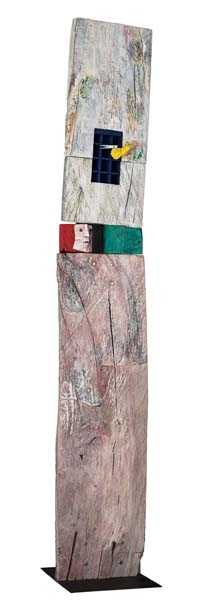About Mehdi Sahabi
Mehdi Sahabi is widely recognized for his translation of Marcel Proust's literary masterpiece, "In Search of Lost Time." Beyond his achievements in translation, Sahabi was also active as a writer, journalist, painter, and sculptor.
He began his artistic studies at the Tehran Academy of Fine Arts. In 1967, he moved to Italy, where he attended a filmmaking course and spent a year studying painting at the Academy of Fine Arts in Rome. After completing his studies, he relocated to France, where he lived until 1971. Upon returning to Iran, Sahabi worked as a journalist and translator, pursuing these professions with dedication until the end of his life. Fluent in English, Italian, and French, he translated numerous notable works into Persian, including "In Search of Lost Time," "Madame Bovary," "Sentimental Education," "The Baron in the Trees," and "Le Père Goriot," among others.
He began his artistic studies at the Tehran Academy of Fine Arts. In 1967, he moved to Italy, where he attended a filmmaking course and spent a year studying painting at the Academy of Fine Arts in Rome. After completing his studies, he relocated to France, where he lived until 1971. Upon returning to Iran, Sahabi worked as a journalist and translator, pursuing these professions with dedication until the end of his life. Fluent in English, Italian, and French, he translated numerous notable works into Persian, including "In Search of Lost Time," "Madame Bovary," "Sentimental Education," "The Baron in the Trees," and "Le Père Goriot," among others.
In the early and most renowned phase of his career as a painter, Sahabi focused on depicting wrecked cars, deformed and crumpled from accidents or disuse. These compositions often included human figures standing nearby, observing or conversing. He held his first solo exhibition in 1989 at Golestan Gallery and continued collaborating with the gallery until 1993, presenting three additional solo exhibitions. In 1990, his works were also featured in a group exhibition at the Tehran Museum of Contemporary Art. His paintings have been exhibited internationally, including in France and Italy.
Although Sahabi was a prominent literary figure, his approach to painting was devoid of literary perspectives. His art was driven by formal and visual concerns, with themes exploring consciousness. Early in his artistic career, he adopted a classical approach to painting, utilizing media such as watercolor, gouache, acrylic, and oil. Later, he shifted toward abstraction, employing techniques such as collage and assemblage, which introduced dynamic patterns and volumes to his works. Art historian Pakbaz highlighted Sahabi's experimental use of materials, noting: "At different periods, he painted and created embossed works with themes such as birds and faces, sometimes reaching complete abstraction. He often crafted forms from scraps of cardboard, plaster, and crumpled paper, employing techniques like scumbling and striation. It seemed he deliberately sought to balance playfulness with careful thought."
Sahabi himself commented on his artistic process, particularly regarding his 2006 exhibition at Aria Gallery, which featured works centered on birds: "These birds are more playful than my other works. I make no particular claims about them. I had no intention of making groundbreaking discoveries. It’s simply a free exercise, a kind of playfulness, among other things."
The Most Expensive Artwork
At Auctions
First Attendance
23 December 2016
# Attendance
12
# Artworks
13
Average Realized Price
11,361 USD
Average Min Estimate
7,723 USD
Average Max Estimate
11,058 USD
Sell-through Rate
92.308%
Average Growth of Artwork Worth
21.354%
Timeline
580 Nanometers / Yellow exhibition
28 November
Treasure 6 exhibition
10 January
Narrative and Material exhibition
8 November
Timeless Creation exhibition
25 October
Abstract Illusions exhibition
11 October
The 21st Tehran - Contemporary Iranian Art auction
11 October
To Doubt or not to Doubt exhibition
13 September
Resize exhibition
16 August
The 20th Tehran- Modern and Contemporary Iranian Art auction
5 July
Wall Allusions exhibition
26 April
Beyond Two Dimensions exhibition
2 February
Display of Sculptures exhibition
2 February
Gozar Project exhibition
19 January
Modern Collectore exhibition
19 January
A Selection of 70 Years of Iranian Sculpture exhibition
4 August
The Flor's Scent And Bird's Song exhibition
5 May
Collector exhibition
15 February
Tehran- 16th- Iranian contemporary art auction
1 July
Resize exhibition
13 May
The last event 1400 exhibition
25 February
The 15th Tehran- Modern Iranian Art auction
14 January
Exhibition of 30 Sculptures by 30 Artists exhibition
24 December
Mehdi Sahabi A Retrospective exhibition
3 November
The 13th Tehran- Modern and Contemporary Iranian Art auction
15 January
After Ten Years exhibition
22 November
Commemoration of the 10th death anniversary of Mehdi Sahabi Mehdi Sahabi exhibition
25 October
دهمین دوره حراج تهران auction
11 January
Lovely Scraps exhibition
4 May
هشتمین دوره حراج تهران auction
12 January
هفتمین دوره حراج تهران auction
7 July
Unseen Paintings exhibition
9 June
The 6th Tehran- Contemporary Iranian Art auction
23 December
Exhibition reviewing the living works of Mehdi Sahabi exhibition
19 February
